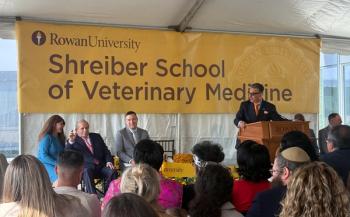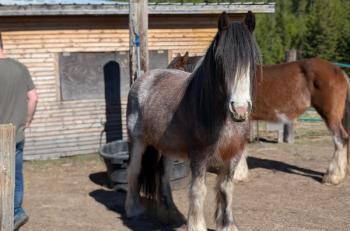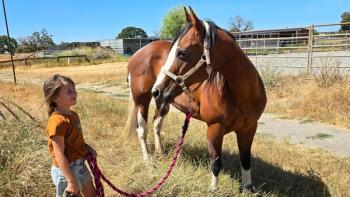
Surgical management of facial trauma (Proceedings)
The horse is prone to traumatic injury of its head. Environmental conditions, a heightened flight response, and equipment and tack used for the horse all contribute to injury occurrence.
The horse is prone to traumatic injury of its head. Environmental conditions, a heightened flight response, and equipment and tack used for the horse all contribute to injury occurrence. Despite the impressive bleeding and often very concerned owner that accompanies initial head injury there are few incidents that are life threatening to the horse; depression fractures of the cranium resulting in cerebral trauma would be one exception. However, an injury can have a significant impact on the horse's athletic performance or appearance, and consequent value to its owner. Wounds that are left to heal by second intention may appear cosmetically unacceptable due to scar contracture or tissue loss resulting in misshapen anatomy. This paper will provide an overview of common facial injuries amendable to surgical repair, with the exception of eyelid lacerations. Lip trauma is covered in the "Managing oral trauma and foreign bodies" proceeding.
General Principles
Successful surgery of the head is facilitated by a rigorous blood supply and close attention to surgical technique. There is often limited soft tissue to work with and wounds are contaminated at initial injury and when paranasal sinuses or nasal passages are penetrated.
Many surgical procedures of the head can be performed in the standing, sedated horse with complementary use of regional anesthesia. The horse can be sedated with detomidine (0.01 – 0.02 mg/kg IV, or 0.02-0.04 mg/kg IM, or 0.06 mg/kg PO) and butorphanol tartrate (0.01 – 0.03 mg/kg, IV) and re-sedated during surgery, if necessary, with additional, smaller amounts of the drugs. Constant-rate infusions (CRI) of detomidine and butorphanol can be administered to provide a prolonged, constant state of sedation, after first sedating the horse with a bolus dose of detomidine and butorphanol. Numerous published concentrations and flow rates of drugs in terms of micrograms of drug per kilogram per minute or drops of a mixture per kilogram per second are available and the reader is encouraged to review that material (eg Goodrich et al, AAEP Proceedings, 2004). A typical practical protocol might be 10 mg of detomidine and 5-10 mg of butorphanol mixed into a 250 ml bag of sterile saline. Once the horse is sedate from its initial bolus doses, the CRI mixture is administered to effect via a standard IV administration set (15 drops/ml) to maintain the initial sedation and adjusted as necessary. One to two bags of this mixture may be used over 1-3 hours, depending on the degree of sedation desired. Facial (maxillary) structures can be desensitized by administering an infraorbital or maxillary nerve block, and the lower jaw can be desensitized by administering a mental or mandibular nerve block (these nerve blocks are covered in detail in the "Regional anesthesia of the equine head" proceeding). Topical infusion of local anesthetic subcutaneously around the wound is often still required for complete analgesia. More complicated, extensive trauma repairs, or particularly head shy, fractious horses are best placed under general anesthesia for meticulous surgery.
Surgical preparation of wounds of the head should be confined to the use of povidine-iodine based solutions or scrub, especially when working around or at the eye, and lavage or rinsing with physiologic sterile saline solution. The use of antimicrobial and nonsteroidal anti-inflammatory drugs follows normal principles for wound management. Antimicrobials are unlikely necessary for successful healing of clean sutured lacerations without deeper structure involvement. Assurance of adequate tetanus prophylaxis is routine. Many facial lacerations are amenable to a pressure bandage applied around the head for compression and protection.
Nostrils
Nostril laceration repair is typically facilitated by minimal contamination and primary closure without excessive tension. Motion at the repair site is a concern, but perhaps less so than for lip lacerations. Debridement should be meticulous and spare all viable tissue. Undermining of the freshened wound margins 5-10 mm reduces motion on the skin layers. A three layer closure is recommended. The internal nostril skin is closed with simple continuous absorbable 3-0 monofilament suture. Vertical mattress size 0 non-absorbable sutures are then placed through the nostril musculature and may be tied over stents (a Penrose drain works well as a soft stent). The external skin is apposed with simple interrupted 2-0 monofilament non-absorbable sutures. Protection of the surgery site by muzzling or cross tying the horse should be considered.
Face
Many superficial, minor lacerations heal with minimal cosmetic blemish and do not require surgery. Large, deep lacerations should be sutured at the earliest time possible after occurrence to achieve an optimal cosmetic outcome. Wounds are carefully debrided and vigorously lavaged to remove hair and other contaminants. A two layer closure is preferable. The deep layer may include subcutaneous and and periosteal tissues and is closed using simple continuous or interrupted absorbable 3-0 to 2-0 suture. The skin is closed with interrupted non-absorbable 3-0 or 2-0 sutures, using tension-relieving and appositional patterns as needed. Lacerations that result in exposed bone with periosteum stripped away (for example, scalping lacerations that occur rostral to the poll and expose temporalis muscle and frontal bone, or degloving injuries over the nasal bridge) require thorough debridement of any exposed bone to reduce bacterial contamination and the risk of sequestrum formation. Debridement can be achieved by high pressure lavage, scraping with a bone curette or scalpel blade, or judicious use of a rotary burr. All available soft tissues are then sutured in layers over the exposed bone to promote its viability.
Crushing injuries to the nasal and maxillary bones can be accompanied by fracture of the nasal septum and conchae resulting in significant airflow restriction and obstruction of the airway due to displacement, edema, and blood clots. A temporary tracheostomy may be needed in the acute phase of management. Nasal septal injury should be reevaluated once healing has occurred as nasal septum thickening or displacement may require its removal if considered a performance limiting airway obstruction. Owners should be forewarned of this possibility. Depression fractures of the facial bones over the paranasal sinuses and nasal passages are ideally reduced while fresh for the best cosmetic outcome (Figures 1 and 2). Open surgical approaches or conservative, minimally invasive approaches may be utilized to gain access to the undersurface of the displaced bone for elevation to its normal contour. Fragments often interdigitate and secure themselves satisfactorily, however fixation with small bone plates or interfragmentary wiring/suturing can be necessary for stability. Fractures involving the pathway of the nasolacrimal duct may cause permanent duct stenosis and chronic tearing of the affected eye. Owners should be made aware of this potential complication. A fluoroscein dye test can check patency of the duct at the time of trauma. Chronic sinocutaneous or nasocutaneous fistulas may develop following full thickness defects over the paranasal sinuses and nasal passages. Reconstruction procedures including muscle transposition flaps, periosteal flaps, and skin flaps or free grafts can be pursued to seal these defects.
Figure 1. Crushing injury across bridge of nose and maxilla. Rotated picture is of horse in right lateral recumbency.
Poll wounds are sometimes complicated by nuchal crest fracture fragments and deep wounds that are difficult to establish drainage for. Radiographs are obtained to determine fracture extent. Loose bony fragments are removed and primary closure of the wound is performed if possible. Negative pressure suction drains are utilized to prevent seroma formation.
Figure 2. Horse in figure 1 healed at 3 months.
Wounds caudal to the lateral canthus of the eye and in front of the base of the ear may involve the temporomandibular joint (TMJ). Penetration of the synovial structures or fracture of the articular bones is possible and principals of open joint injury care are applicable for the TMJ. Effective imaging of the TMJ can be difficult and recent publications have described various oblique and tangential radiographic views to more clearly define the TMJ. Ultrasonography is useful and CT scanning is optimal. Septic arthritis of the TMJ may respond to standard local and systemic therapies as for any septic synovial structure. A chronically painful TMJ might be resolved by performing a mandibular condylectomy in select cases.
Large, full thickness cheek injuries that penetrate the oral cavity are reconstructed to prevent oro-cutaneous fistula development. Working on the oral side can be difficult because of limited space. Suturing the wound from the external side, starting with the mucosal layer using size 3-0 or 2-0 absorbable monofilament suture, may be more practical. Tension relieving vertical mattress sutures (size 0 to #1) should be used for the musculature and the skin is closed with simple interrupted sutures, size 0 to 2-0. Soft tissue defects that cannot be sutured due to excessive tissue loss still have the propensity to contract and seal over without chronic fistula formation. Regular lavaging of the wound with saline or dilute antiseptic solution to keep it clean of oral cavity contamination is necessary in these cases.
Infrequently a facial wound will also include a severed salivary duct or gland, most often the parotid structures. A clear discharge is detected in the normal wound exudate. Loss of duct or gland integrity is suspected because of the anatomical location of the wound and is confirmed by observing a significant increase in clear secretions from the wound bed when the horse eats. Open wound management and second intention healing is often appropriate for many lacerations involving salivary structures. Salivary fistulas that may develop are frequently self limiting and spontaneously close with no long term complications, particularly for wounds involving the glands. Lacerations of the ducts are more likely to develop persistent cutaneous fistulas. Treatment of lacerated salivary ducts may be by primary surgical closure and this is facilitated by suturing the duct over an intraluminal tube or by placing three sutures to appose the two cut ends as a triangle and suturing between the apices. The duct is closed with fine absorbable or non-absorbable suture (5-0 to 7-0) using a simple interrupted pattern. The cutaneous wound is sutured or left open to heal by second intention. Alternatively, the associated gland can be destroyed and this is easier and more practical than reconstructing a duct. Horses can lose one parotid salivary gland without known complications. Gland destruction is by chemical involution or physiological atrophy following duct ligation. For chemical involution 35 ml of 10% formalin is infused into the gland by inserting a catheter via the fistulated entrance to the duct. The solution is retained in the gland for 90 seconds and then allowed to drain out. The catheter is left in place for 36 hours. Saliva secretion ceases over about 3 weeks. Duct ligation is done between the gland and the fistula or freshly severed duct by catheterizing the duct and dissecting down to the duct palpable beneath the skin. Size #2 or #3 sutures (fine gauge sutures may cut the duct wall when tied) are preplaced around the catheterized duct before the catheter is withdrawn and the sutures tied. If the severed duct location is difficult to determine in a fresh wound, the intact duct may be more readily located as it passes over the surface of the tendon of insertion of the sternomandibularis muscle. The duct can be ligated at this point, and also more distally after catheterization and a second incision to approach the duct, to be sure any distal radicles are ligated as well.
Any facial wound with extensive soft tissue loss that cannot be closed primarily is managed as an open wound and allowed to granulate, contract and epithelialise. If exposed bone sequesters it will need to be removed in most instances before wound healing will continue to completion. If a soft tissue defect does not close over, transpositional skin flaps may be elevated and rotated over the defect to assist closure. Skin grafting is also a reasonable option for facial wounds with non-epithelialised defects. Given the relative shallow bed of granulation tissue to work with in the head location, punch, pinch, or split-thickness mesh grafts probably have the most ease of application and best chance of survival compared to tunnel or full thickness grafts.
Ears
The ear is susceptible to bite wounds and lacerations. When left to heal by second intention a thickened, curled, forked-tipped or blunted pinna may result that might be considered cosmetically unacceptable. Therefore acute lacerations are closed primarily whenever possible. The ear canal should be protected with cotton wool or gauze during preparation of the ear for surgery. Sterile gauze can then replace the non-sterile packing at the commencement of surgery. Tissue preservation is paramount when debriding wound margins as there is minimal tissue available to draw over sizeable defects if primary closure is being attempted. Only skin margins are sutured together with care taken not to penetrate underlying cartilage so as cartilage thickening and subsequent deformity of the ear are avoided. Simple interrupted or continuous 3-0 non-absorbable monofilament suture is placed, apposing skin margins on the concave and convex sides of the pinna independently. Ears with large cutaneous defects that cannot be sutured can be managed with a skin graft to aid the best cosmetic outcome. To support an unstable ear a splint fashioned from radiographic film or similar material can be sutured to the inner surface of the pinna with full thickness mattress sutures. Rolled gauze may also be secured to the internal pinna with elastic tape and serve as a splint. Bandaging is not recommended to reduce the tendency for a horse to rub and self-mutilate the repair. Cross-tying may be helpful. The skin sutures and splint are removed in 12-14 days.
References
Hubbell JAE. Practical standing chemical restraint of the horse. Proceedings of the 55th Annual Convention of the AAEP 2009;55:2-6.
Goodrich LR, Clark-Price S, Ludders JW. How to attain effective and consistent sedation for standing procedures in the horse using constant rate infusion. Proceedings of the 50th Annual Convention of the AAEP 2004;50:229-232.
Ebling AJ, McKnight AL, Seiler G, et al. A complementary radiographic projection of the equine temporomandibular joint, Vet Radiol Ultrasound 2009;50:385-391.
Townsend NB, Cotton JC, Barakzai SZ. A tangential radiographic projection for investigation of the equine temporomandibular joint, Vet Surg 2009;38:601-606.
Howard RD, Stashak TS. Reconstructive surgery of selected injuries of the head. Vet Clin North Am: Equine Pract 1993;9:185-198.
Barber SM. Management of neck and head injuries. Vet Clin North Am: Equine Pract 2005;21:191-215.
Newsletter
From exam room tips to practice management insights, get trusted veterinary news delivered straight to your inbox—subscribe to dvm360.






